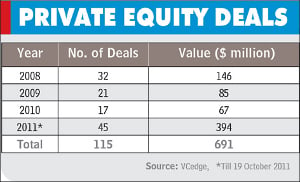Many online players are stepping out to aggressively advertise on traditional media to get more business
 What is common to Flipkart, Olx, Quikr, Yehbhi and Communitymatrimony apart from the fact that they are online brands? Well, they all share ad space with the Pepsis, the Cokes and the Airtels of the world on television. And are equally visible on print too.
What is common to Flipkart, Olx, Quikr, Yehbhi and Communitymatrimony apart from the fact that they are online brands? Well, they all share ad space with the Pepsis, the Cokes and the Airtels of the world on television. And are equally visible on print too.According to industry estimates, in the last two years, online companies have increased their ad spends on TV by a staggering 445 per cent. In 2009, online companies together spent Rs 58.4 crore on television. That figure leapt to Rs 201 crore in 2010. This year, in just ten months (January to October) ad spends by online brands have raced way past the previous year's figure to Rs 315 crore. At this rate they could end up close to Rs 400 crore for 2011-more than six times that were spent two years ago.
The story is no different when it comes to advertising in print media. It's estimated that online brands occupied print ad space worth close to Rs 266 crore between January and October. Radio is smaller, but spends still went up from Rs 4.5 crore in 2009 to Rs 7.7 crore in 2010. This year (January-October), that figure has almost quadrupled to Rs 30 crore. These figures, however, do not include spends by media houses-or their associate companies-which use their own media, be it print, television or radio.
An example of the above would be the Times Group properties like Magicbricks or Indiatimes. The advertising spends against some of their names are so stupendous that only a media-linked or owned brand would have spent that kind of money. Naaptol (that had a private equity deal with the Times Group some time ago), for instance, consumed print media space worth Rs 555 crore this year. Leaving them out might be unfair but including their advertising spends would certainly distort the real picture.
What is it that is pulling so many new age companies to use traditional media to showcase themselves?
Inspired move
It was Naukri.com that started it all. Way back in 2004, it came up with its first TVC that had a painful, irritating boss at the centre of things. Two years after this came the unforgettable Hari Sadu TVC. After a hiatus, Hari Sadu made a comeback in 2010 and took the stage by storm again. Bharatmatrimony was another online pioneer that went the TV commercials way to spread its message.
Success stories like these sparked off an offline advertising rush among digital brands. For long, digital brands were quite happy about using the online medium to generate leads and invite potential customers on to their respective websites. As the search for new customers and brand building intensified, they moved to the traditional advertising route.
 Today, most online companies spent 20-30 per cent of their total advertising and marketing budgets online. The rest goes into traditional media. Ravi Vohra, vice president (marketing), Flipkart, one of the largest advertisers on TV among online brands, says, "Traditional media helps create a feeling of reliability and authenticity amongst consumers." Is this trend the proverbial flash in the pan? No, believe industry experts. They opine that this trend is here to stay and will continue to grow together with the digital business.
Today, most online companies spent 20-30 per cent of their total advertising and marketing budgets online. The rest goes into traditional media. Ravi Vohra, vice president (marketing), Flipkart, one of the largest advertisers on TV among online brands, says, "Traditional media helps create a feeling of reliability and authenticity amongst consumers." Is this trend the proverbial flash in the pan? No, believe industry experts. They opine that this trend is here to stay and will continue to grow together with the digital business.





